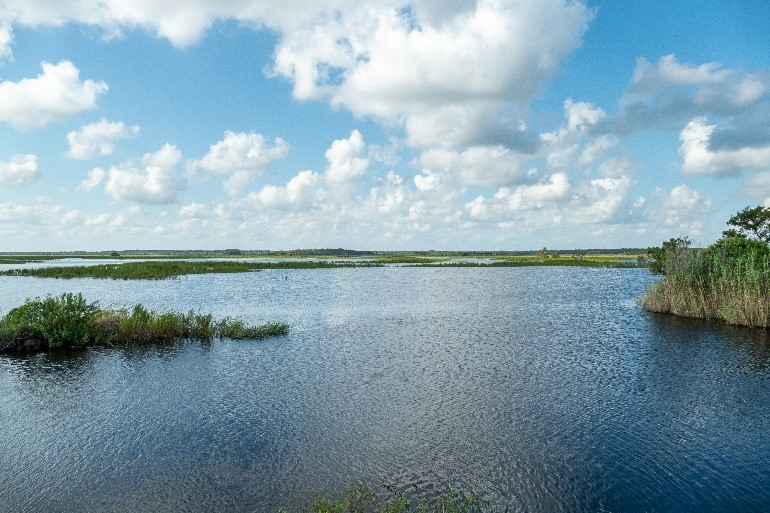
The good news for the St. Johns River is its health continues to improve. The bad news is its tributaries are not in great shape and need some attention.
Hurricane Ian didn’t help matters.
“In Central Florida, about 10 million gallons of sewage spilled into our tributaries, and so with us being downstream, that impacts us,” St. Johns Riverkeeper Lisa Rinaman said to the Cuppa Jax civic discussion group.
“Even though we’re so fortunate to live in Jacksonville with this gorgeous river running through the heart of our community, we have to remember we’re downstream. We’re downstream from a lot of communities — there’s 18 counties that actually drain into the St. Johns River watershed.”
The river is only as good as its tributaries and wetlands, she said.
Earlier in the week came the lower St. Johns River report, an annual effort over the last 15 years, which is funded by the city of Jacksonville Environmental Protection Board in order to inform the public about the health of the lower St. Johns River basin and provide independent assessments.
Health of the river, in this circumstance, is judged on how it supports human well-being like recreation, the status of algal blooms, biodiversity, and similar issues.
“As in the previous year, one of the important conclusions is that for the most part, the main stem of the river — what we call the main part of the river — is reasonably healthy in terms of water quality, making the river suitable for boating, fishing and other forms of recreation,” said Charles Closmann, an associate professor specializing in environmental history at the University of North Florida.
Closmann spoke at a rollout of the report this week produced by WJCT.
“Some of the other good news from the St. Johns River report this year is there are plenty of the most popular fish that people would like to fish for, including red drum, spotted sea trout, mullet,” Closmann said. “There’s some uncertainty about other popular fish, like catfish, but some of the fish that are extremely popular for recreational fishermen are quite common and doing quite well right now.”
Recreation is only one part of the picture, though.
“While water quality in the main part of the St. Johns River is generally suitable for boating, fishing and other forms of recreation, sadly the river is not OK and there is much more to be done to protect and restore the St. Johns River and its tributaries,” Rinaman said.
Specific progress was made on nitrogen pollution in the river over the past few years, she noted.
“Nitrogen is one of the two types of nutrients that fuel the blue-green algae blooms that we see in the river, and fortunately on nitrogen we’re doing well,” Rinaman said. “We’re actually at satisfactory condition, and a lot of that is the investment that’s been done by JEA, the city of Jacksonville, and industry to meet their regulatory requirement to reduce nitrogen in the river.”
Gains made from nitrogen reduction, however, are undermined by increasing phosphorous, loss of wetlands and eelgrass, saltwater intrusion and continuing toxic blue-green algae outbreaks.
Some species of concern in the past, like wood storks, are thriving in the area.
“Bald eagles are doing quite well in this region,” Closmann said. “In the lower St. Johns River basin, manatees seem to be doing pretty well, although they face certain threats due to declining submerged vegetation and likely increase in boat traffic in future years.
“So, the conclusion is while they’re doing (OK) right now, it’s certainly something we need to take a good look at in future years. As many of you probably know, there have been problems with manatee populations declining in the Indian River Lagoon. So, this is a sort of warning to keep an eye on this.”
The St. Johns’ tributaries are where scientists are most concerned.
“Some of the tributaries are quite badly polluted,” Closmann said.
Jones Creek, Little Pottsburg Creek’s freshwater segment and the upper reach of the Trout River are all impaired by E. coli. The Trout River’s upper reach is also impaired by lead. Moncrief Creek is in particularly bad shape. Copper, iron and nutrients impact its marine segment, while iron also affects the freshwater segment. Iron and nutrients both impair the marine segments of Pottsburg Creek, and enterococci pollutes the marine segment of Dunn Creek.
As with any Florida environmental issue, development and the loss of critical habitat come into focus again as well, with wetlands losing out to urban development and agriculture, along with other factors.
“In fact, urban development, agriculture, runoff from roads and so forth are also factors that cause pollution in some of the tributaries,” Closmann said. “Of course, wetlands are incredibly important as breeding grounds for all sorts of fish and support for ecosystems and so forth.”
Salinity is also a problem. The river doesn’t change much in elevation from the upper St. Johns to the coast, so saltwater intrusion is an increasing worry thanks to sea-level rise and decades of dredging activity. Observers noticed an increase in the past year, and believe it could be having a negative effect on submerged vegetation, which impacts manatees.




One comment
Impeach Biden
October 20, 2022 at 3:54 pm
The river will be full of Liberal tears when DeSantis is crowned King of America!
Comments are closed.